Gait Abnormalities
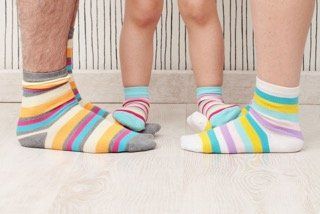
Knock Knees or Inturned Knees
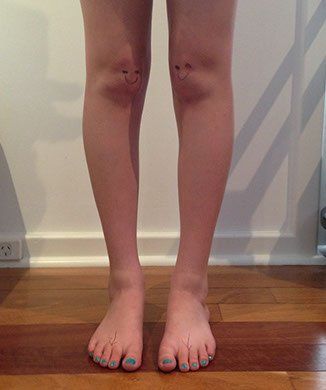
Presentation
- Femurs (thighs) internally rotated
- Knee caps face toward each other when walking
- +/- inward turning of tibia and feet
- Excessive rotation of pelvis in stance and swing phase of gait
- Knock-knees / in-turned legs in conjunction with pigeon toes
- Inturned position is often more pronounced at the end of the day when child is fatigued
- Child often sits in a "W" position
- +/- Hip or patello-femoral pain with weight-bearing sports
- +/- Complain of lower leg/shin pain at end of day or at bed time
- May occur on its own or in combination with pigeon toe feet
Possible Causes
- Femoral anteversion (hip internal rotation > 70 degrees)
- Ligamentous laxity of hips causing excessive internal rotation of hips and thighs with associated weakness of pelvic and hip muscles
- Genu valgus
Non-Surgical Management Options
- Core and pelvic stability exercises
- Strengthening of pelvic and hip musculature
- Proprioceptive exercises
- Spiral Thigh Brace for biofeedback and gait re-education worn for 4-5 hours a day for a period of 3-6 months or as indicated by health professional
- Customised orthotics to avoid overuse of feet and encourage control of movement from the pelvis and lower trunk
Pigeon toe gait
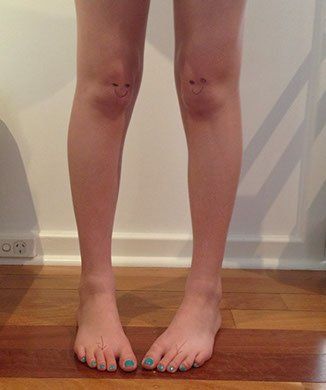
Tip toe walking
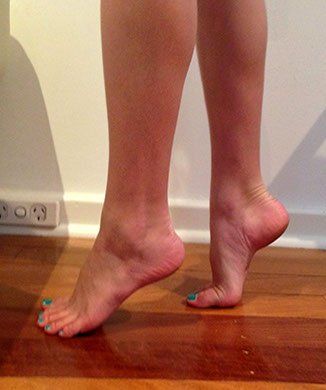
Tip Toe walking can be a feature of a number of type of childhood disorders including:
(i) Cerebral Palsy (CP)
Increased neurological tone and/or spasticity in the lower limbs is a cause of toe waking. The spasticity in the legs can cause the calves to tighten and reduce in length, forcing the feet into a plantar flexed (pointed position). The tightness in the calves reduce child’s ability to rest heels on the ground. In addition children with CP often have very weak muscles in the lower limbs making walking with the correct muscles very difficult. Tip toe walking is an adaptive walking pattern to allow the child to locomote despite weak pelvis muscles and tonal changes.
(ii) Hypermobility Disorders
Children with hypermobility often have ligamentous laxity in the hip/knee/ankle joints. In association with this it is quite common for the proximal muscles (core/pelvis/hip) to be weak and the longer distal muscles (hamstrings /calves ) to be strong. Hypermobile children are often unable to stabilise or control movement efficiently due to weakness around the pelvis and thus overuse the calf muscles as an adaptive mechanism to facilitate walking.
(iii) Autism Spectrum Disorders (ASD)
There is a higher incidence of hypermobility and ligamentous laxity in the ASD population in comparison to the normal population. Like the hypermobile group, weakness in the trunk and and pelvis predispose these children to overuse of the calves and hamstrings and thus tip toe walking.
Signs and Symptoms in Tip Toe Walkers
- Child walks on tip toes with heels raised off floor
- Gastroc-soleus (calf muscles) muscles often look well developed
- Decreased length of gastroc-soleus and hamstrings
- Changes in foot shape due to abnormal weight bearing (fan shaped forefoot/ flat foot/ pronated foot or pes cavus)
- Weakness in hip and pelvic muscles
- Often have weakness in core muscles
- May complain of lower leg/calf or shin pain
- +/- increased tone in lower limbs (in cases of cerebral palsy)
Non-Surgical Management Options
- Stretching of tight muscles groups (gastroc-soleus and hamstrings)
- Strengthening of pelvis muscles (especially gluteus medius and quadriceps) and core stability muscles
- Botox ( in cases where increase tone is a cause)
- +/- Spiral Th igh Brace or Spiral Power Shorts for gait retraining
- +/- Orthotics from a podiatrist to reduce overuse of ankle foot and stabilise foot so that child is encouraged to use hip muscles to control movement and balance as opposed to using tip toes
A child who has tip toed since they started to walk and has maintained the pattern for years, often has no memory or concept of what it feels like to walk in a different or more normalised pattern . The Spiral Thigh Brace is a biofeedback tool to facilitate motor learning and development of new motor memories to help the body and brain to learn to walk in a more normalised pattern. Like an exoskeleton, the Spiral Thigh Brace is body hugging and allows freedom of movement while controlling the direction of movement.
- Feet / toes point inward when walking
- Inturned legs (thighs or thighs and lower legs)
- Often is in association with flat or over-pronated feet
- Often more pronounced at end of day when feeling more tired
- Increased incidence of trips and falls
- Sits in “W” position
- Onsets between 1.5 and 2.5 years of age for children
- Self corrects in milder cases by age of 5 for children
- Sometimes as a result of intrauterine “packaging” of family history
- Femoral anteversion (hip internal rotation > 70 degrees)
- Ligamentous laxity of hips and associated muscle weakness
- Medial tibial torsion
- Metatarsus adductus (forefoot deformity)
- Spasticity (eg. in cerebral palsy)
- Core and pelvic stability exercises
- Strengthening of pelvic and hip musculature
- Proprioceptive exercises
- Flexible bracing garments for biofeedback and gait re-education worn for 4-5 hours a day for a period of 3-6 months or as indicated by your health professional. In cases when femoral anteversion, ligamentous laxity of the hips or CP are causes of the pigeon toe walking then the Spiral Thigh Brace is an excellent therapy tool. People are often prescribed strengthening exercises for the lower limb in an attempt to improve the pattern of walking. Despite strengthening the muscles, gait patterns often remain unchanged due to ingrained motor patterns , adaptive changes and posturing. The child or adult often has no memory or concept of what it feels like to walk in a different or more normalised pattern . The SpiralThigh Brace is a biofeedback tool to facilitate motor learning and development of new motor memories to help the body and brain to learn to walk in a more normalised pattern. Like an exoskeleton, the Spiral Thigh Brace is body hugging and allows freedom of movement while controlling the direction of movement.
- Customised orthotics for correction of forefoot deformities and tibial torsion
Duck Feet or Waddling gait
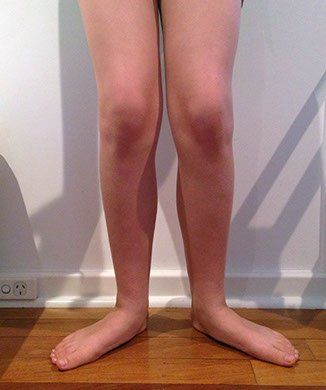
- Excessively turned out feet (duck feet)
- Often delayed walker
- Often in association with flat feet
- Reduced hip movement in swing phase of gait
- Commonly decreased lumbar lordosis in standing (flat back)
- Hips and lower trunk slightly flexed (leaning forward) in gait
- Weakness in pelvis including gluteus medius and weak core muscles
- Walks and runs with heavier awkward looking run with poor push-off. Tires quickly when running and may avoid weight-bearing sports. Often seen in children with endomorph shape (carry weight around tummy/trunk) and coexisting hypermobility. Often seen in association with coordination difficulties.
- Femoral anteversion with external tibial torsion (inturned hips and out-turned lower legs)
- Femoral retroversion, tight hip external rotator with tibial torsion (out-turned hips and lower legs)
- Stretching of external rotators of the hips
- Avoid sleeping prone. Night splinting for prolonged stretching
- Core and pelvic stability exercises
- Strengthening of pelvic and hip musculature
- Gait re-education
- Customised orthotics
- Proprioceptive activities
- Spiral Thigh Brace for gait re-education and biofeedback
- Core and pelvic stability exercises
- Strengthening of pelvic and hip musculature
- Gait re-education
- Customised orthotics